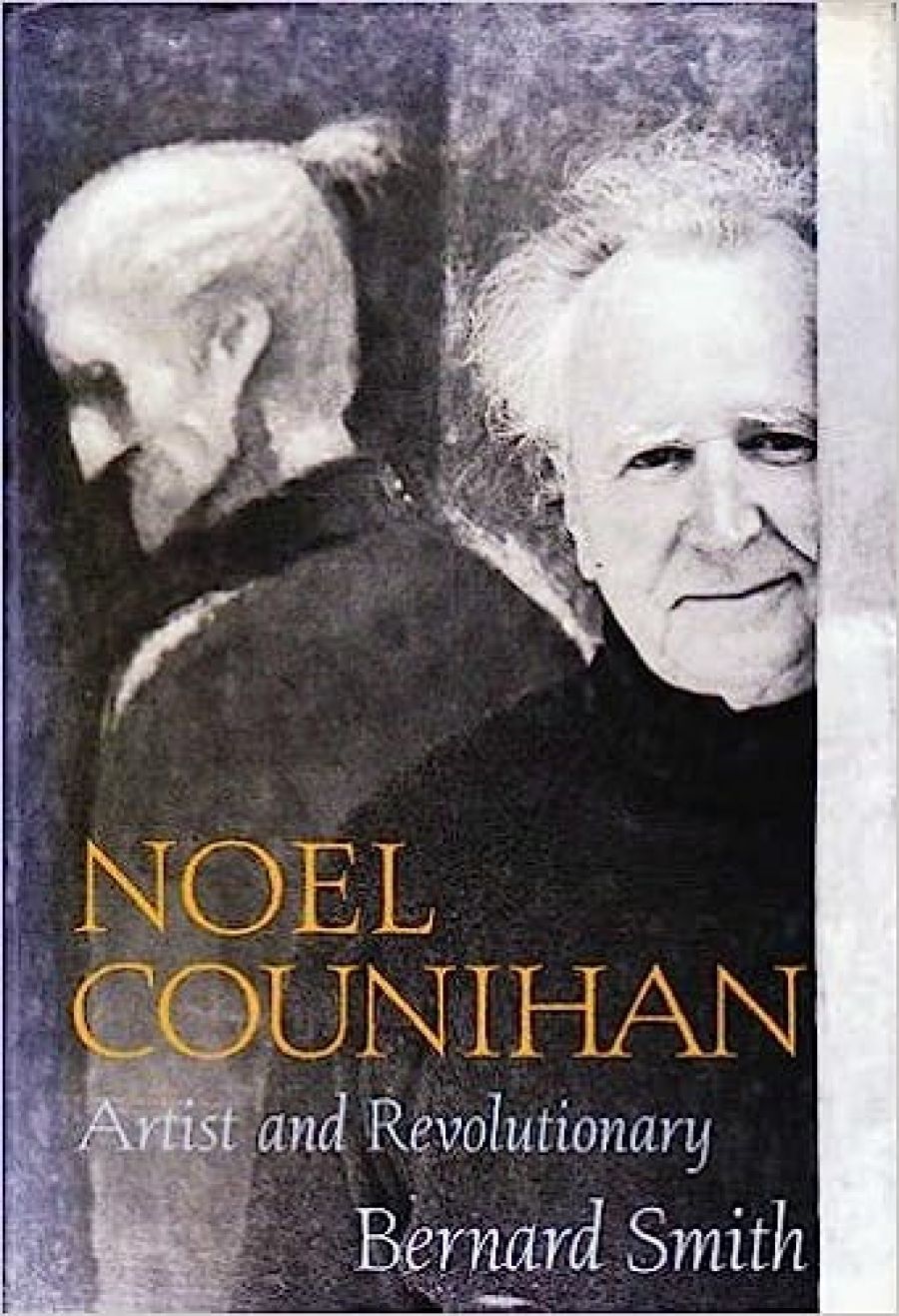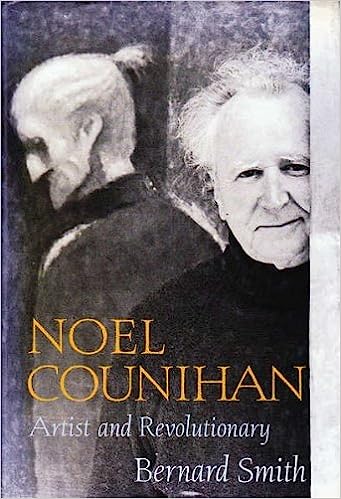
- Free Article: No
- Contents Category: Biography
- Custom Article Title: At the end of the march
- Review Article: Yes
- Article Title: At the end of the march
- Online Only: No
- Custom Highlight Text:
His extract from the 1940 New Zealand Police Gazette reproduced on the back cover of this splendidly designed biography acts as a striking metaphor for the life and times of Noel Counihan, artist and revolutionary.
- Book 1 Title: Noel Counihan
- Book 1 Biblio: OUP, $59.95 hb
- Book 1 Cover Small (400 x 600):

Not that Counihan was static in his beliefs. Probably his greatest achievement was there making of himself so that by the end of his life he was a very different Communist to the fervent dogmatic young ideologue who joined the Australian Communist Party (ACP) in the Depression. The story of his personal struggle gives the biography much of its pathos, energy and interest.
Meticulously researched, with an impressive accumulation of detail, Bernard Smith’s book allows us to participate in the fascinating history of that remaking. He argues that in the biography he has used his own voice ‘only to counter what seems to me to be excessive bias and prejudice’. This is of course a simplification and his own particular ideological bias, without which the sympathy would probably be impossible, helps to give an added bite to the telling. There is no doubt that the Cold War and the hysterical anticommunism of the period did much to obscure Counihan’s achievement so that it took twenty to thirty years for his work to be accepted as part of the general culture.
It as a period of great artistic achievement in Australia and the often bitter and acrimonious battles between rival ideologies are still capable of raising hackles today. In 1959 Bernard Smith’s Antipodeans, a group of figurative artists united in their hostility to abstract art, produced a manifesto and an exhibition of their work. Interestingly Counihan was not invited to join them because of his public adherence to Socialist Realism. Elwyn Lynn, writing about the Antipodean manifesto in the Australian, Jan. 15, 1994, said:
That retardataire manifesto condemned all abstraction as art's enemy and left the Sydney avant-garde then with two clearly defined enemy groups; the Charm School and the Antipodeans – both groups making replications as easily as they made money.
In that section of the biography where Counihan speaks about his art, he says:
I suppose that At the Start of the March, 1932, painted in 1944, has probably been reproduced more than any similar painting in our modern history. Now it is accepted and regarded as a classic. At the time it was painted it was considered political propaganda.
The other side of the equation was the attitude of the ACP itself to his work. In 1965, he was commissioned by the ACP Central Committee to paint a large mural in the conference hall of their new building in Day St, Sydney. They wanted a mural that the delegates to the ACP national conference would approve, ‘a simple statement expressing their hope for a better future for humanity’.
‘This is literally the biggest thing in my artistic life,’ Counihan wrote to Jack Lindsay, but when he invited criticism of the draft cartoon from anyone who cared to make it, controversy raged. ‘It possessed elements of abstraction, obscurantism and surrealism’, it was ‘a concession to idealism’, it depicted ‘broken spirited humans’, and ‘there was little that marked the contents as Australian’. His communist critics wanted the utopian dream of socialist realism, not the bleak realistic austerity of the working-class struggle. Counihan accepted the criticism and scrapped his original design.
The ACP, as much as it was interested in art at all, was wedded to the dogma of Soviet Socialist Realism, a Zhadnov construct of the 1930s which had nothing to do with realism but rather with depicting a utopian society led by an idealised working class. Counihan was a social realist wedded to the critical depiction of life as it is but his total commitment to the Communist Party often pushed him into the unhappy role of an artist defending the indefensible. The two linchpins of his political belief were the labouring working class as the ideal icon, the Soviet Union as the idealised vision of a socialist homeland. His tragedy was that in his life time he saw the diminution of that labouring class as a force in Australian politics and the total discrediting of the Soviet Union as the working class utopia. Like many young revolutionaries whose beliefs were formed in the Depression, he’d clung to that vision long after it ceased to have any validity.
For a later generation the blind idealism of those who joined the Communist Party in those early years is difficult to understand but arguably those beliefs did help to order and discipline their lives. It was a period of great turbulence and acrimony and Counihan was involved in all the political, social and artistic issues often to the neglect of his own work. He lived at the heart of a dilemma. On one side was the open hostility of the arts establishment, on the other the unrelenting pressures of the ACP bureaucracy with its narrow dogmas and demands.
Till the end of his life Counihan remained an enemy of formalism. ‘The prevailing aesthetic philosophy of Sydney art critics’, he wrote, ‘is an expression of what I regard as the crisis in modern art, its formalism and dehumanisation. But in an interview in1981 after an exhibition of his work at the Perth Festival, he said he disliked artistic tags of labels because they put people in boxes: ‘I don’t like that as much as I might have when I was young.’ He had no interest in ‘going back to the Soviet union or China with the flashing teeth and the full Colgate smile marching valiantly to a radiant future which of course is all rubbish’. He was ‘profoundly interested in the problems of painting and the agony of developing an artistic language’.
In 1988, after his third cardiac arrest, Noel Counihan died. After his death Max Harris, one of his old sparring partners, wrote:
As we grow older and look through a glass we grow kinder, one begins to see not what we saw then but what the artist saw. Kathe Collwitz saw out the corner of her mind ideologically. I preferred Counihan who recorded only pity and pain, then left it at that. It was not his task to combine the people and the past. The artist leaves us with that to do ourselves. That was the point John Reed and I got from our aesthetic positions. Counihan was one of us.
Reading Bernard Smith’s biography of Noel Counihan is, for me, a bit like taking a trip in a time capsule. I only met Counihan once, at a party in Melbourne in 1959. He had a reputation as a hard-line political ideologue but his warmth and charm were so immediate I found myself confiding the story of the recent traumatic breakup with the father of my three young sons. ‘You’ve got your whole life ahead of you,’ he said. ‘Go out and live it.’ I shared the times and the prejudices, the beliefs and battles – published at first with the Angry Penguins, attacking them three years later in the Workers Star and, forty-three years later in the year of Counihan’s death, writing an appreciation of their contribution to Modernism – the struggle to remake myself as a writer parallels Counihan’s struggles as an artist.
In the epilogue of this biography, Bernard Smith makes his final claims for Counihan as a precursor of the postmodernists, a ‘creative critique of the constraints latent within formal ism and abstraction’. It is a daring re-evaluation of an artists who was seen by many of his contemporaries as an enemy of Modernism, but history has a strange habit of overturning old categories.


Comments powered by CComment